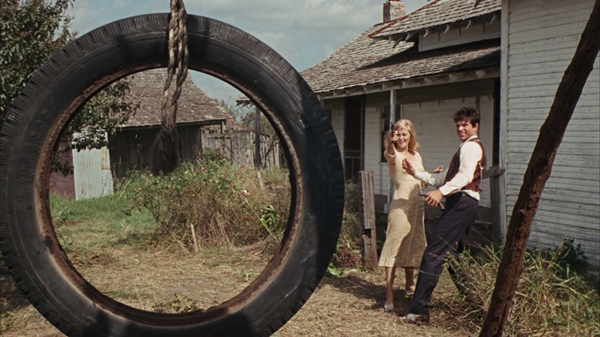
Haunting Endurance Cinema: Harmony Korine’s Trash Humpers
Written by: Tony Lazlo, CC2K Staff Writer
I can’t in good conscience recommend Harmony Korine’s haunting Trash Humpers to everyone. But there’s a certain subset of our audience who’ll find it irresistible.
Maybe you grew up in the sticks. Maybe you had a burnout friend in high school who liked nothing more than to dig trenches in the neighbor’s yard with his pickup truck. Maybe you grew up around smalltown bigots and racists who were one or two years away from serious jail time. Maybe you fled to the big city to escape all that, avoiding any trips back home for fear of lapsing into a depressive state because of the influx of old memories.
Or maybe you like Johnny Knoxville’s Jackass franchise, and you just like to smash things. That’s OK, too. Korine’s “movie” — I add the scare quotes only because I can’t honestly describe it as anything approaching a traditional narrative — doesn’t discriminate. All it does is present a series of demented vignettes featuring three actors in atrocious old-person makeup who explore a series of dilapidated, disintegrating and decrepit locales somewhere in the south. (I’m pretty sure it was all shot outside of Korine’s native Nashville.)
That Korine is a fellow southerner doesn’t surprise me. He presents these locations with a real eye for authenticity. Sometimes it’s hard to find movies that deal with the south as it is, with all of its concrete-paved neighborhoods, lack of sidewalks, piss-yellow night-time streetlamps, crabgrass, kudzu, and untold thousands of rickety houses that old-timers have called their homes for decades. As insane as it sounds, Trash Humpers made me flash on the grimly gorgeous location shooting for Bonnie and Clyde, which also portrays the south as it is — or was.

I also thought back to the novels of the late, great Larry Brown, a Mississippian who wrote about rednecks, hicks and good-ole boys with the best of ‘em. There aren’t any great film adaptations of Brown, but Arliss Howard made a serviceable — if self-serving — take on one of Brown’s novellas, Big Bad Love. Check out the trailer, which includes several images that would be right at home in Trash Humpers:
Shot on film, the rural south has a gutter-poetic quality to it. Those crumbling wood houses look like old gravestones, pocked with acid rain and bad memories. Howard’s movie isn’t great, but he knows where to point his camera. Ditto for Korine — and speaking of which, let’s talk about his excellent choice to shoot Trash Humpers on that most maligned of formats: old-school, shitty VHS.
To be sure, Korine could have only shot this movie on VHS. It pitches itself (roughly) as a found-footage feature, where we’re simply peeking in on the shenanigans of three elderly sociopaths. The trappings of first-generation VHS lend the proceedings a ghostly, nightmarish quality. Images (and scenes) bleed into each other with staccato, jagged jump-cuts, interspersed with blue null footage, the sound fritzing in and out all the while, all of it dusted with bursts of static. Alerts for “play,” “stop,” “rewind” and “tracking” flash across the screen, untouched by an editor’s hand. It looks like the kind of deranged home movie your buddy Cooter shot on his handheld back in the day. (And if you didn’t have a buddy named Cooter, well, you’re missing out on the best in life.)
But let’s pause and get back to my lede: That I can’t recommend Trash Humpers to everyone, even though I think it’s a haunting love/hate letter to the rural south. To that end, let’s look at the movie itself. Here’s an indicative — and very NSFW — scene:
I mentioned the Jackass movies — which also feature a recurring bit about people in horrendous old-person makeup, incidentally — and like those gag-fests, there’s an element of so-called “endurance cinema” to Trash Humpers. Much of the movie is shrill and off-putting, and there are several scenes intended to be shockers: A Faces of Death-style onscreen murder; a young child in a suit cackling as he smashes a baby-doll with a hammer; an idiotic poem spoken over the image of an unconscious (dead?) man’s body, his balls in plain sight. I suspect it’s the kind of movie that would inspire a few walk-outs, and that’s a pity.
But if you can make it through the movie’s lean 74-minute running time, there’s a chance you’ll feel what I felt — a bone-deep, aching sadness. It’s a sadness that comes from looking at those run-down old houses and their country-fried residents. There’s a heady streak of condescension in that sadness, of course, and Korine calls it out through one of his characters. You can hear part of his speech at the 27-second mark of the movie’s trailer:
“What I don’t understand is … we choose to live like free people,” he says. He goes on to say: “I can’t imagine living like this.” (Paraphrased.)
Part of that sadness includes a real critique of middle-American culture, with its cocksure pride in being ignorant. I hate to lump everyone in middle America into that same benighted group, and that’s where the condescension comes in. But whether you see Korine’s movie as a jeering ode to all things redneck or as a backdoor takedown of flyover country’s persistent confirmation of the Dunning-Kruger effect, the movie itself is disturbing, hypnotic, nightmarish, ghoulish — and original as hell. Highly recommended.

